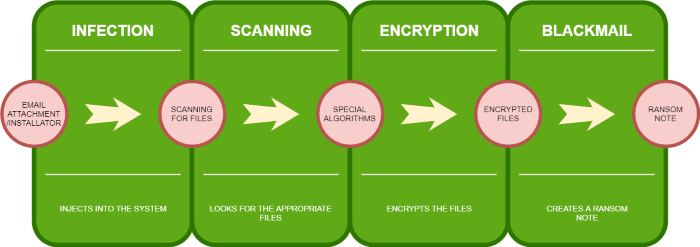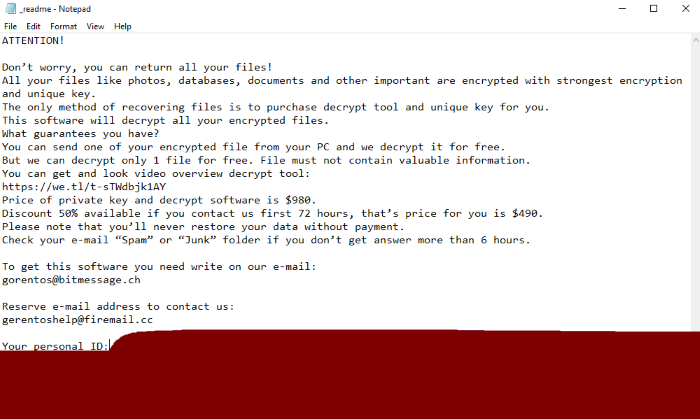Mike ransomware encryption process
Mike ransomware belongs to STOP(DJVU) file-encryption ransomware family. The viruses of this type are aimed at the changing of file structures. In the most cases Office documents and media files are exposed to the risk of being encrypted. The creators of Mike ransomware use various ways to spread it, but most commonly they the spam email attachments. They inject malicious code into a harmless file and once the recipient of the message opens this attachment, the device is already infected. If you are infected with this type of malware, don’t try to remove Mike ransomware extension from the names of encrypted files! There is a great risk of damaging the data permanently.

Once the virus injects into the system, it immediately proceeds malicious processes, that we can call “encryption“. The very first step of the virus is to scan your hard drive. The scanning process is aimed at the detection of Office documents and media files. This process can hardly be noticed, as the encryption requires some time and any interfering with it can possibly prevent hackers from getting money. Then the virus encrypts suitable files and the result of it is unreadable files. The virus changes the extensions of these files to .Mike ones and then creates a ransom note, that is called _readme.txt. This note contains the following information:

_readme.txt
ATTENTION!
Don’t worry, you can return all your files!
All your files like photos, databases, documents and other important are encrypted with strongest encryption and unique key.
The only method of recovering files is to purchase decrypt tool and unique key for you.
This software will decrypt all your encrypted files.
What guarantees you have?
You can send one of your encrypted file from your PC and we decrypt it for free.
But we can decrypt only 1 file for free. File must not contain valuable information.
You can get and look video overview decrypt tool:
https://we.tl/t-sTWdbjk1AY
Price of private key and decrypt software is $980.
Discount 50% available if you contact us first 72 hours, that’s price for you is $490.
Please note that you’ll never restore your data without payment.
Check your e-mail “Spam” or “Junk” folder if you don’t get answer more than 6 hours.
To get this software you need write on our e-mail:
gorentos@bitmessage.ch
Reserve e-mail address to contact us:
gerentoshelp@firemail.cc
Your personal ID:
*ID number*Don’t trust in their words and save your money! There is no a single reason to believe in their words, as they can easily make the situation even worse! Instead of decryption tool they can send you some questionable software that possibly can steal your accounts, passwords, contacts and destroy all data. If you wonder, how to remove Mike ransomware and decrypt .Mike files, you can use our guide for free!
Article’s Guide
- How to remove Mike Ransomware from your computer
- How to remove Mike Ransomware encryption from your files
- Data Recovery
- Automated decryption tools
- Windows Previous Versions
How to remove Mike Ransomware from your computer?
We strongly recommend you to use a powerful anti-malware program that has this threat in its database. It will mitigate the risks of the wrong installation, and will remove Mike from your computer with all of its leftovers and register files.
Solution for Windows users: our choice is Norton 360 . Norton 360 scans your computer and detects various threats like Mike, then removes it with all of the related malicious files, folders and registry keys.
If you are Mac user, we advise you to use Combo Cleaner.
How to decrypt .Mike files?
Once you’ve removed the virus, you are probably thinking how to decrypt .Mike files. Let’s take a look at possible ways of decrypting your data.
Recover data with Data Recovery

- Download and install Data Recovery
- Select drives and folders with your files, then click Scan.
- Choose all the files in a folder, then press on Restore button.
- Manage export location.
The download is an evaluation version for recovering files. To unlock all features and tools, purchase is required ($49.99-299). By clicking the button you agree to EULA and Privacy Policy. Downloading will start automatically.
Restore data with automated decryption tools
Unfortunately, due to the novelty of Mike ransomware, there are no available automatic decryptors for this encryptor yet. Still, there is no need to invest in the malicious scheme by paying a ransom. You are able to recover files manually.
You can try to use one of these methods in order to restore your encrypted data manually.
Restore data with Windows Previous Versions
This feature is working on Windows Vista (not Home version), Windows 7 and later versions. Windows keeps copies of files and folders which you can use to restore data on your computer. In order to restore data from Windows Backup, take the following steps:
- Open My Computer and search for the folders you want to restore;
- Right-click on the folder and choose Restore previous versions option;
- The option will show you the list of all the previous copies of the folder;
- Select restore date and the option you need: Open, Copy and Restore.


